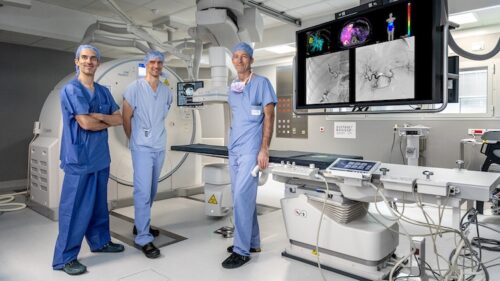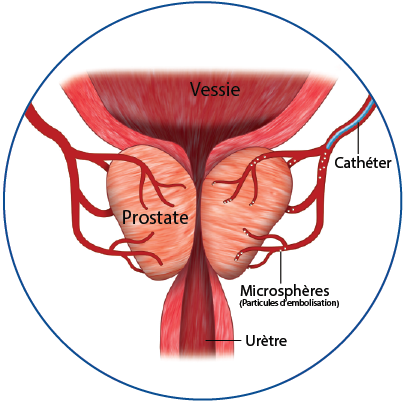Prostate Center Paris
Prostate artery embolization : preserve your sexuality

Based in Paris, the prostate center stands out as one of the largest in Europe in terms of the number of patients treated by this innovative technique. It brings together several interventional radiologists specializing in prostate embolization, a non-surgical alternative for treating swollen prostate problems. This minimally invasive procedure is performed on an outpatient basis, enabling rapid recovery and immediate resumption of activities.
The pioneering role of the prostate center
The Prostate Center has positioned itself as a pioneer in recognizing the importance of medical innovation. It adopted the use of smaller microspheres long before this practice became widely accepted, basing this decision on extensive research and clinical experience demonstrating the benefits of this approach. Our studies show a clear reduction in recurrences with this method. What's more, bladder catheterization is no longer necessary with EAP.
Prostate adenoma: Treatment and full diagnosis
Prostate adenoma or BPH : What is it?
A prostate adenoma is a common medical condition in older men. It is a non-cancerous growth of the prostate, the gland beneath the bladder that surrounds the urethra. The urethra is the channel through which urine passes from the bladder to the outside of the body. It's a common pathology in men aged 50 and over. Find out more about prostate adenoma.
Symptoms of prostate adenoma
Common symptoms of prostate adenoma are urinary disorders:
- difficulty initiating micturition
- a weak urine stream.
- a feeling of incomplete bladder emptying
- urinary retention.
- Pollakiuria: Frequent urinary desire
- They are caused by compression of the urethra by the adenoma. The reduction in urethral diameter considerably impedes bladder emptying. Find out more about symptoms
Prostate artery embolization: a minimally invasive treatment
The prostatic artery embolization treatment is a non-invasive, outpatient procedure. The procedure involves a catheter inserted into the artery at wrist or groin level, which is guided to the prostatic arteries.
Microbeads are inserted to reduce the blood supply to the prostate, thereby reducing its size. This procedure is not performed by a urologist, but by an interventional radiologist. Prostate embolization in detail
Why won't my urologist talk to me about prostatic artery embolization?
There may be several reasons why your urologist didn't tell you about the prostatic artery embolization technique. Some possibilities include:
- Limited knowledge : Not all doctors are aware of all the techniques available. Medicine is a vast and constantly evolving field, and your urologist may not be aware of the latest advances or all the options available.
- Personal preference : Some doctors may have personal preferences regarding the treatments they recommend, based on their experience and expertise. Although embolization is a minimally invasive alternative to surgery.
- Treatment availability : The availability of different techniques may vary according to geographic region, local medical resources and treatment protocols specific to the facility where your urologist works.
Is it true that patients experience a recurrence of symptoms after prostate embolization?
It is important to note that recurrence of symptoms after an EAP is not systematic, and a small percentage of patients may experience such recurrence. Several factors can influence the outcome, such as small-vessel revascularization of the prostate is one aspect to consider.
Prostate embolization is designed to reduce blood flow to the prostate by obstructing the arteries that supply the gland. This usually relieves the symptoms of benign prostatic hyperplasia (BPH). However, it is possible that some smaller blood vessels not targeted by the procedure may contribute to partial revascularization of the prostate over time.
This revascularization can be seen as the body's natural process of maintaining the blood supply necessary for normal prostate function. It may explain why some patients experience a recurrence of symptoms, although this remains relatively rare.
PROSTATE CENTER NEWS
Direct percutaneous puncture of the prostatic artery
A failure rate of almost 0%
The Centre de la Prostate in Paris is the first center to implement such a revolutionary method in the world of interventional radiology.
Study of 30 patients referred to our center for failure of prostatic embolization by catheterization (usual embolization).
Prostate embolization and effects on sexual function
A comparison of different prostate adenoma treatment techniques.
Verdict: Prostatic artery embolization does not affect sexual function.
Read the rest of our article about embolization and its effects on sexual function
A more precise approach to embolization
The Prostate Center is one of the few French centers to promote 100-300 microspheres for embolization. In the meantime, a review of the literature has just confirmed the superiority of these small microspheres. As a result, the recurrence rate is considerably reduced.
Article published on PubMed - Read the scientific article
2000-patient prostate embolization study
CEAP study onprostatic artery embolization : 2000 patients treated.
Our study shows 96% with very satisfactory results, with no major complications for patients treated by embolization.
Read more about our study on the results of prostatic embolization
Prostate embolization: a natural technique that preserves sexuality
Prostatic artery embolization is a medical procedure used to treat enlarged prostate, also known as benign prostatic hyperplasia (BPH). This technique is less invasive than traditional prostate adenoma surgery, and aims to reduce the urinary symptoms associated with this condition.
First, the patient is positioned on a vascular table, enabling visualisation of all the arteries in the human body. The interventional radiologist applies a local anaesthetic to the groin, or wrist (in rare cases). Thanks to the unique experience acquired at our center, it is no longer necessary to insert a urinary catheter during the procedure.
An interventional radiologist then inserts a catheter into the patient's femoral artery (in the thigh) or radial artery (in the wrist). Guiding the catheter through the blood vessels to the prostate artery, the doctor then injects small particles (called microspheres) into the arteries supplying the prostate to reduce blood flow to the organ. This has the effect of reducing the blood supply to the prostate, leading to shrinkage of the prostate gland and an improvement in urinary symptoms.
With less blood supply, the prostate shrinks in size, making it easier for urine to pass through.
Unlike surgery, however, there is no such thing as sexual or urinary complications and no retrograde ejaculation. Embolization has no adverse effect on erection.
EAP is generally considered as a treatment option for men with mild, moderate and advanced prostate enlargement who do not wish to take conventional drug treatments due to their side effects. The procedure can offer advantages such as shorter hospital stay, less pain and faster recovery than conventional prostate adenoma surgery, without significant side effects.
"The UK's National Institute for Health and Care (NICE) states that prostate embolization is now the standard treatment for BPH (benign prostatic hyperplasia). All the medical studies confirm the benefits of this new procedure.

Illustration of prostatic artery embolization treatment

